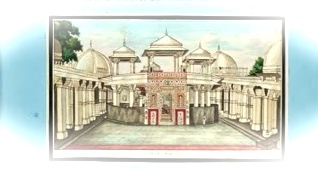
Qadam Sharif in Delhi
Dr.
Mazhar Naqvi
‘Qadam Sharif’ (Footprint of Holy Prophet) of Delhi today
may not be famous like Red Fort, Qutub Minar or Jama Masjid but it was
certainly one of the most revered shrines till the partition of India. Built by
Sultan Firoz Shah Tughlaq in 14th century in Paharganj area of Delhi,
the shrine was a repository of spiritual power and popular adulation
during the reigns of Shah Jahan and Aurangzeb.
Till 19th Century, the relic's blessed run-off water was dispensed to the devotees and it was part of a far larger architectural complex and included a ‘Maktab’ (School), Mosque, Baoli (Watertank) and other buildings. After 1947, Muslim population of the entire locality migrated to Pakistan. Demands refugees from Pakistan and human habitation put extraordinary pressure on the site and it began to suffer from neglect. The shrine and its associated buildings were originally enclosed by four 14th century battlemented walls but these and the gates on the north and west sides vanished within the last hundred years as they have been absorbed into contemporary construction.
Till 19th Century, the relic's blessed run-off water was dispensed to the devotees and it was part of a far larger architectural complex and included a ‘Maktab’ (School), Mosque, Baoli (Watertank) and other buildings. After 1947, Muslim population of the entire locality migrated to Pakistan. Demands refugees from Pakistan and human habitation put extraordinary pressure on the site and it began to suffer from neglect. The shrine and its associated buildings were originally enclosed by four 14th century battlemented walls but these and the gates on the north and west sides vanished within the last hundred years as they have been absorbed into contemporary construction.
It is believed that a stone bearing the footprint of the Prophet was brought to India during the reign of Firoz Tughlaq by a celebrated devotee who was sent by Sultan to Mecca to obtain from its Shreiff a Khilat (robe of Honor).In addition,Shreiff also gave a stoner bearing the footprint of the Prophet. Firoz Shah received the holy relic at a distance of 15 Kms from Delhi on its arrival. It was escorted with much Pomp and finally deposited by order of the Emperor in the Royal Treasury. It so happened that once Sultan asked his beloved son Fateh Khan to chose from the treasury whatever he liked most. Fateh selected the relic but his father refused to hand over the blessed footprint to him. When the prince insisted and reminded Sultan of his promise, a settlement reached between the two that relic will be placed over the grave whoever dies first. Unfortunately, the prince died on the twelfth day of Safar in 776 (23 June 1374) near Badaun in Uttar Pradesh. Deeply distressed at his death, Sultan withdrew from governance and left Delhi to visit the tomb of Syed Salar Masud Ghazi at Bahraich. He ordered construction of a marble mausoleum around Saint's tomb and undertook erection of a structure bearing resemblance to the one designed for Bahraich around the grave of his son after returning to Delhi. He honoured his words by placing the blessed relic inside the mausoleum and soon it came to be known as Qadam Sharif. Later Mughal Emperors and even the British Raj paid attention to Qadam Sharif. In his book, Syed Ahmad Khan has mentioned that an annual fair used to be held at the shrine on 12th of Rabi-Ul-Awwal. Thousands of Malang Faqirs also used to be part of the festivities and perform ecstasies in front of shrine’s gate.'An idea about the popularity of the shrine can be formed from the description of Dargah Quli Khan in his Muraqqa-e-Dehli. He Writes" Every Thursday the courtyard of the Dargah is so full of visitors that it is difficult even to approach the Place and touch it. Pilgrims and ascetics come from countries far and near to seek fulfilment of their wishes.”
Heavily Encroached Entrance of Qadam Sharif
After remaining
in a state of utter neglect, the shrine is now cleaned by a religious preacher
on a regular basis and he also offers flowers over the relic. However, much is
still needed to restore the lost glory of the shrine that once enjoyed the
status of the most popular place of pilgrimage and was a visual treat architecturally.
Obviously, the shrine requires government initiative to get itself liberated
from the encroachment and neglect from the concerned bodies like Delhi Wakf Board, ASI and
INTACH.

Qadam Sharif in the Album of Thomad Metcalfe
References:
1-Text written by Sir Thomas Metcalfe (1795-1853), the Governor-General’s Agent at the imperial court.
2-‘Muraqqa-e-Delhi’ by Dargah Quli Khan
3-Muslims Today, December 17,Rana Safavi
4- Ansar-as -Sanadid (Great Monuments) by Sir Syed Ahmad Khan
5- Photo Courtesy-Google images )

Qadam Sharif in the Album of Thomad Metcalfe
References:
1-Text written by Sir Thomas Metcalfe (1795-1853), the Governor-General’s Agent at the imperial court.
2-‘Muraqqa-e-Delhi’ by Dargah Quli Khan
3-Muslims Today, December 17,Rana Safavi
4- Ansar-as -Sanadid (Great Monuments) by Sir Syed Ahmad Khan
5- Photo Courtesy-Google images )
No comments:
Post a Comment